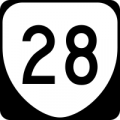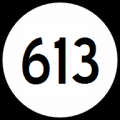(*/Major_roads/Main*/) |
|||
| Line 3: | Line 3: | ||
:''For further information, see [[Road names/USA]], [[Road types/USA]] and [[Virginia/Resources]].'' | :''For further information, see [[Road names/USA]], [[Road types/USA]] and [[Virginia/Resources]].'' | ||
:''The following is intended for Virginia Specific roadways. For further information about Interstates and US Highways and other non-Virginia roadways, see [[Road names/USA]], [[Road types/USA]] and [[Virginia/Resources]].'' | |||
<gallery> | <gallery> | ||
File:Virginia 28.png|Primary route marker | File:Virginia 28.png|Primary route marker | ||
File:VA_613.PNG|Secondary route marker | File:VA_613.PNG|Secondary route marker | ||
</gallery> | </gallery> | ||
==== Locking | ===Naming=== | ||
Virginia folows the [[Road Names (USA) | road naming guidelines of the USA]]. The local name of a road should always be set as the primary name and the route number should be set as an alternate name; there are very few state routes in Virginia that do not have a local name. | |||
'''Primary state routes''' have numbers in the range of 2 to 599 (and, as exceptions, 785, 895), displayed in a route marker using a shield design. Using the example above, the road should be named '''SR-28'''. | |||
'''Secondary state routes''' are those with route numbers 600 or greater; if these roads have route markers (many do not), they use a circle design or a small rectangle instead of a shield. Using the example above, the road should be named '''VA-613'''. | |||
'''Frontage roads''' are roads run parallel to a higher-speed, limited-access road. A frontage road is often used to provide access to private driveways, industries, farms, etc.. A list of these roads can be found [http://www.vahighways.com/route-log/fseries.htm here.] They should be named '''F-###''' | |||
'''Town Roads''' or T-Roads are roads that are maintained by incorporated towns on an optional basis. They should be named '''T-###''' | |||
===Road typing=== | |||
Virginia follows the [[Road Types (USA) | national guidelines for road types]]. | |||
VDOT Functional Classification | |||
The VDOT Functional Classification Maps have been approved for setting road type in WME based on the quick reference chart and other considerations listed below.The functional classifications are available via an interactive map that can be found [http://www.arcgis.com/home/webmap/viewer.html?webmap=3eca6c9adb6649c988d98734f85baddb here]. Alternatively, maps have been made to match WME in both [http://arcg.is/1FxkS9x old] and [http://arcg.is/1ez6BwY current] road colors. | |||
[[File:VA_FC.png|center]] | |||
For purposes of applying the US road type guidelines, we treat only primary state routes as "numbered state highways." Primary state routes must be designated as at least [[Road Types (USA) #Minor_Highway|{{Minor Highway}}]] in Waze, unless the road's functional classification requires a higher designation. (For example, primary routes '''785''' and '''895''' are road typed to reflect their future designation as freeway.) | |||
'''Exception''': Primary routes that solely access state facilities (parks, educational/correctional institutions, etc.) should be given a road type that matches the FC maps published by VDOT, even if that is less than Minor Highway. Many, but not all of the routes that service state institutions are '''SR-3##'''; a non-exhaustive list can be found [http://en.wikipedia.org/wiki/State_highways_serving_Virginia_state_institutions here.] | |||
Secondary state routes, frontage roads, and town roads are always typed based solely on the FC maps | |||
Consult the [[Road Types (USA)]] page for further guidance on how to type based on functional class and road signage. | |||
===Locking=== | |||
In Virginia we have a set minimum standard for locking roads based on segment type. Any road of a certain segment type must be locked at least to the rank (level) in the chart below. Roads may be locked higher for protection and special situations (areas with construction, tricky design, frequent mistakes, imaging inaccuracies, and the like), but should not be locked lower. | |||
A great time to implement these locks is while bringing the road types of an area into compliance with the current [[Road Types (USA) | US road type standards.]] Lock the roads based on type after they've been set to current US road type standards and connecting roads are set up correctly and all other edits are complete for the segment. | |||
{{Lock Standard State|VA}} | {{Lock Standard State|VA}} | ||
<!-- | <!-- | ||
Revision as of 22:47, 21 October 2015
- For further information, see Road names/USA, Road types/USA and Virginia/Resources.
- The following is intended for Virginia Specific roadways. For further information about Interstates and US Highways and other non-Virginia roadways, see Road names/USA, Road types/USA and Virginia/Resources.
-
Primary route marker
-
Secondary route marker
Naming
Virginia folows the road naming guidelines of the USA. The local name of a road should always be set as the primary name and the route number should be set as an alternate name; there are very few state routes in Virginia that do not have a local name.
Primary state routes have numbers in the range of 2 to 599 (and, as exceptions, 785, 895), displayed in a route marker using a shield design. Using the example above, the road should be named SR-28.
Secondary state routes are those with route numbers 600 or greater; if these roads have route markers (many do not), they use a circle design or a small rectangle instead of a shield. Using the example above, the road should be named VA-613.
Frontage roads are roads run parallel to a higher-speed, limited-access road. A frontage road is often used to provide access to private driveways, industries, farms, etc.. A list of these roads can be found here. They should be named F-###
Town Roads or T-Roads are roads that are maintained by incorporated towns on an optional basis. They should be named T-###
Road typing
Virginia follows the national guidelines for road types. VDOT Functional Classification The VDOT Functional Classification Maps have been approved for setting road type in WME based on the quick reference chart and other considerations listed below.The functional classifications are available via an interactive map that can be found here. Alternatively, maps have been made to match WME in both old and current road colors.

For purposes of applying the US road type guidelines, we treat only primary state routes as "numbered state highways." Primary state routes must be designated as at least Minor Highway in Waze, unless the road's functional classification requires a higher designation. (For example, primary routes 785 and 895 are road typed to reflect their future designation as freeway.)
Exception: Primary routes that solely access state facilities (parks, educational/correctional institutions, etc.) should be given a road type that matches the FC maps published by VDOT, even if that is less than Minor Highway. Many, but not all of the routes that service state institutions are SR-3##; a non-exhaustive list can be found here.
Secondary state routes, frontage roads, and town roads are always typed based solely on the FC maps
Consult the Road Types (USA) page for further guidance on how to type based on functional class and road signage.
Locking
In Virginia we have a set minimum standard for locking roads based on segment type. Any road of a certain segment type must be locked at least to the rank (level) in the chart below. Roads may be locked higher for protection and special situations (areas with construction, tricky design, frequent mistakes, imaging inaccuracies, and the like), but should not be locked lower. A great time to implement these locks is while bringing the road types of an area into compliance with the current US road type standards. Lock the roads based on type after they've been set to current US road type standards and connecting roads are set up correctly and all other edits are complete for the segment.
Actual locks used may be more or less than values in the table below, depending on area circumstance
Please consult the RC, SM, or appropriate AM for guidance
| Segment Type | Urban | Rural | |||||||||
|---|---|---|---|---|---|---|---|---|---|---|---|
| Freeway | 5 | ||||||||||
| Ramp | Highest rank of connected segment | ||||||||||
| Major Highway | 4 | 3 | |||||||||
| Minor Highway | 3 | 2 | |||||||||
| Primary Street | 2 | 1 | |||||||||
| Street | 1 | ||||||||||
| • • • • Ferry • • • • | 5 | ||||||||||
| |-|-|-|-|-|-|-|-|-| Railroad |-|-|-|-|-|-|-|-|-| | 2 | ||||||||||

